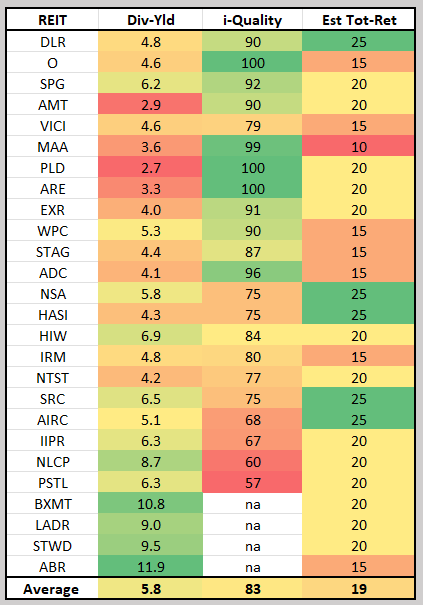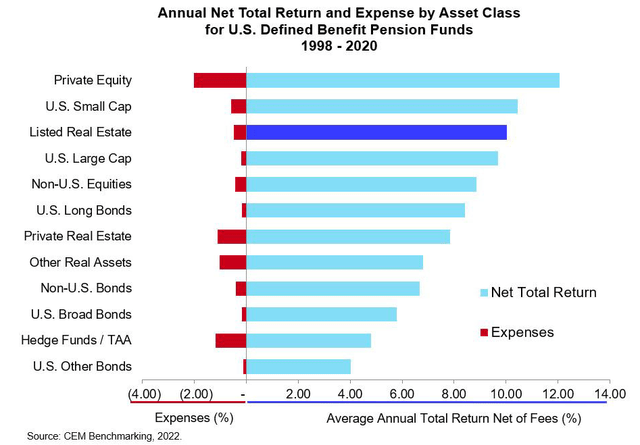Dzmitry Dzemidovich
Unless this is your first time reading my articles – and maybe even then – you know I’m a big fan of real estate investment trusts, or REITs. But I don’t always explain why that’s the case.
Honestly, to some degree, I automatically expect my readers will know what I’m talking about. And many of you do, in my defense.
You do either because you’ve been following me for a long time or you learned about REIT basics elsewhere and want to delve further into the topic. Or maybe both.
If you fit that bill, then you’re probably happy I don’t write more of these introductory explanations. Then again, perhaps you always skip the opening segments regardless and go right for the REIT recommendations.
You’re the reader, so the decision is ultimately in your court.
But for those of you who are just learning about the sector, I do want to take today to explain several reasons why it’s so valuable. Ten reasons, to be precise.
Let’s get right to them without further ado…
REIT Reason No. 1: Diversification
REITs are both diversifying and diversified, a combination that can easily strengthen your portfolio.
This is true of any investment asset category to some degree or another, admittedly. Pick a category, any category, and you’ll find that kind of opportunity.
Take precious metals, for instance.
The grouping involves gold and silver, of course, but also platinum, palladium, and titanium. So there’s diversification right there. But then you can divide each of those into groupings like physical bars and coins, mines, exchange-traded funds (“ETFS”), and the like.
That’s what I mean by “diversified.” As for “diversifying,” precious metals – or any other asset class – offer the opportunity for you to add to your holdings, spreading your money between very different categories that ultimately strengthen your financial standing and protect your profits.
If one investment or category falters and even fails, it only represents a portion of your holdings. This is enormously important for investors to practice to some degree or another.
Which is why I like REITs. Here’s the kind of diversifying and diversified benefits they offer:
- 208 REITs are in the FTSE Nareit All REITs Index
- 170 REITs trade on the New York Stock Exchange
- NYSE listed REITs equity market capitalization = $1.148 trillion
- 32 REIT ETFs that trade in the US (excluding inverse and leveraged ETFs).
That last consideration is especially varied, with apartment, hotel, gaming, timber, billboard, hospital, office, data center, cell tower, industrial, and self-storage REITs at your disposal, to name just some of them. REITs give you access into so many different industries, including entertainment, healthcare, travel, communications, and commodities.
Moreover, they’re all built on a sturdy, stable landlord platform that overall offers reliable dividends on top of price appreciation possibilities.
www.ireitinvestor.com (REITs Around The Globe)
REIT Reason No. 2: Transparency
That first one was a particularly long entry in this pre-recommendation segment. But it’s hardly the only important consideration.
We also need to consider how publicly traded REITs are a great way of investing in real estate without excessive risk of the unknown. This isn’t always true of “regular” real estate options, where you can get assessments, it’s true.
But you’re probably not going to see detailed, year-by-year and quarter-by-quarter histories of how profitable or unprofitable they were. To quote Nareit, however:
“Independent directors, analysts, and auditors, as well as the business and financial media monitor list REIT’s performances and outlook. This oversight provides investors with a measure of protection and more than one barometer of a REIT’s financial condition.”
I could go on from there, but that would take me into different reasons to really like these companies. So I’ll just end this segment with the encouragement to keep reading.
It gets better from there…
REIT Reason No. 3: Liquidity
I’m all about owning real estate flat-out in the form of personal homes. Those can be very good investments, indeed.
If you have the right resources and temperament, and are operating in the right area, being a landlord can be profitable as well. However, you have to understand either way that selling said properties, should you so choose, will take time. Perhaps even a lot of it.
Not so much with REITs, though.
With REITs (of the publicly traded variety, that is), you can buy and sell shares with the click of a button. It might take a few minutes for the trade to actually go through, of course. And if you’re looking to buy or sell at a very particular price, it might take longer than that.
But the fact is that it’s very little time-specific inconvenience to purchase real estate in this regard. In fact, it’s about as convenient a purchase as possible.
REIT Reason No. 4: Dividends
I mentioned dividends briefly before, but they are perhaps the biggest motivation to buy REITs.
Not every example is going to be a dividend-paying goldmine, mind you. But the way the sector is structured, they do tend to pay higher-than-average yields.
In order to exist as non-taxed entities, REITs must pay out at least 90% of their taxable income to investors. This means that, not only can the payouts be higher per share…
They can be just as safe or even safer than other dividend stock offerings.
That’s a big deal, especially in this risk-filled investing environment we’re dealing with right now.
REIT Reason No. 5: Management
This brings me back to REIT Reason No. 2: Transparency. The part where I said I could go on but wouldn’t just yet.
Nareit’s note about oversight does definitely apply to “independent directors, analysts, and auditors.” The same goes for the “business and financial media” that monitor “listed REIT’s performances and outlooks.”
However, as I’m sure Nareit also acknowledges, much of that base information they’re working with comes from management disclosures. And that management tends to be on the conservative side in all the right ways.
This goes back in large part to the REIT structure that siphons away so much of the companies’ taxable income. That limits the amount of money they can throw around at riskier ventures, which tends to keep management in check.
Then again, that very structure tends to attract more conservative types to begin with. While you will find some “wheelin’ and dealin’” types in the REIT world, they’re not the norm.
REIT Reason No. 6: Performance
When we hear “conservative” in the markets, it’s easy to translate that into a slew of unattractive supposed synonyms.
- Boring.
- Lackluster.
- Unappealing.
- Even pointless.
Why bother investing in something that’s going to take “for-ev-er” to profit when you can have instant gratification elsewhere?
It’s an understandable view. But reality proves it to be pretty far off the mark, all things considered.
This makes sense when you really think about it. Because you’re not just getting share price appreciation here, which, yes, comes at a slow-but-steady pace. There’s very little fast-and-furious in this sector compared to, say, tech stocks.
That makes people forget to focus on the “steady” part of that description. Held over years, reliable price appreciation adds up… often without stomach-churning drops that so often make investors sell too soon.
Add in consistent dividends – especially consistently reinvested dividends – and you’ve got something that easily keeps pace with other asset classes. Or beats them entirely.
Need proof of that? No problem. I’m happy to answer the skeptics.
In fact, I encourage it. So does Nareit, which provided this graphic in a recently published article:
As it highlights, “Listed equity REITs had the third-highest average annual net return over the period, 10.0%.”
Not too shabby, right?
REIT Reason No. 7: Proven
By proven, I mean “battle-tested.”
REITs are hardly the oldest asset class on the market. But their six-decade history does show they’ve been through a lot…
And learned from every bit of it.
Signed into law in 1960, “The concept was pretty popular right out of the gate,” I wrote in The Intelligent REIT Investor Guide. Unfortunately, President Kennedy’s assassination in 1963 threw everything into turmoil, halting many a REIT IPO in the process.
“According to The REIT Investment Summary, a 1996 report published by Goldman Sachs, there were really only 10 of these businesses worth noting in that first decade. The companies in question ran portfolios worth $11 million to $44 million, and many of them were attached to management companies that were affiliated with members of their boards. It goes without saying that this could and did easily create issues.”
But little by little, the sector got things figured out until it really came into its own in the 1990s. That’s when, thanks in large part to Nareit’s efforts, institutional investors started getting involved.
“At the end of 1990, [REITs’] market cap was estimated at $5.6 billion. By the close of 1994, it had risen to $38.8 billion. A year later, it was up to $60 billion – still a micro industry but a growing one nonetheless, with new subsectors such as malls, outlet centers, industrial properties, manufactured home communities, self-storage properties, and hotels.”
There were still lessons to learn from there, to be fair. This was particularly true as the housing market crashed and the Great Recession set in. But once again, the sector emerged bigger and better from the chaos.
It forced REITs to realize the benefits of a new level of fiscal conservatism that many of them haven’t let go of since.
REIT Reason No. 8: Retirement
The very definition of retirement is not having a job anymore. Obviously.
Which means retirees need other sources than a traditional paycheck to sustain themselves. Also obviously.
Yes, they have Social Security to rely on. For now. But that’s not enough.
Facts are facts.
But let me refocus your attention on another fact: how REITs have higher-than-usual dividend yields.
I of course recommend investing in these companies as early as possible – well before you retire, I mean. That way, by the time you do reach retirement, you’re working with just the dividends and some significant stock price appreciation as well.
With that said, I routinely write articles for retirees alone. REITs really are a great consideration for any age group at any stage of life.
REIT Reason No. 9: Made for Average Joe and Jane
They’re also excellent across most income levels.
As I also explain in my book, REITs were legalized on the premise that mom-and-pop investors deserved to have a piece of the commercial real estate pie too. Before the 1960s, that was just a rich man’s game; it took some serious money to invest in buildings.
And while those rich men could lose a lot of money from such projects…
They could make a lot of money too. Like “a lot” a lot.
REITs changed the game. They made it so just about anyone could own and gain from property. Entire portfolios of properties, for that matter.
Yes, it might just be fractions of those portfolios. But that’s what makes them affordable.
Besides, those fractions completely exclude the costs, considerations, and hassles of being a landlord. Shareholders can simply hand their money over to responsible industry experts and watch their dividends come rolling in from there.
No muss. No fuss. No favoritism.
REIT Reason No. 10: Because I Said So
Reason No. 10 is clearly the least impressive of the lot. And I do mean it somewhat tongue-in-cheek.
But it’s not a complete joke. And it’s not arrogant at all.
My life today is a testament to how well one can do by investing in REITs – even when “one” is starting out with a crashed and burned business, and overwhelming amounts of debt and responsibilities.
I was a self-made man before the 2008 crash, and it went to my head. Today, I’m a REIT-made man, living by much more conservative financial principles that keep me:
- From buying into foolish market investments based on peer pressure or “googly eyes”
- Diversifying my portfolio to maintain a balanced portfolio that can go the distance
- Sleeping well at night knowing I bought into quality, dividend-paying stocks at reasonable or better prices.
That’s what REITs can offer – when handled appropriately, of course. And that’s why I wouldn’t trade them for my old fast-and-loose lifestyle.
Trust me when I say so.
One Bonus Reason
As most of my readers know, I have been writing on the Seeking Alpha platform for over twelve years, and during this time I have written three business books, all of which include real estate content.
In addition, I teach real estate at many leading colleges and universities, such as Cornell University, New York University, The University of North Carolina, Georgetown University, Clemson University, and others.
Prior to writing on Seeking Alpha, I was a real estate developer and investor, in which I learned the secrets to value creation over almost three decades.
While I was successful in the private side of real estate, I could have never amassed the wealth I have today without the use of REITs. Thanks to all of the above-referenced reasons (1-10), all of us can gain access to some of the most dominant companies in the world.
I’m building my retirement portfolio around dominant players like:
- Digital Realty (DLR)
- Realty Income (O)
- Simon Property Group (SPG)
- American Tower (AMT)
- VICI Properties (VICI)
- Mid-America Apartment (MAA)
- Prologis Inc. (PLD)
- Alexandria Real Estate (ARE)
- Extra Space (EXR)
- W. P. Carey (WPC)
I own all ten of these REITs and I’m continuing to accumulate shares when my team and I see a justifiable margin of safety. In addition, I own shares in REITs that are smaller, but are also able to generate steady and predictable alpha, such as:
- STAG Industrial (STAG)
- Agree Realty (ADC)
- National Storage (NSA)
- Hannon Armstrong (HASI)
- Medical Properties (MPW)
- Highwoods Properties (HIW)
- Iron Mountain (IRM)
- NETSTREIT Corp. (NTST)
- Spirit Realty (SRC)
- AIR Communities (AIRC)
More so, there are many other specialty sectors that I find appealing, but of course, our team analyzes these securities at a granular level. I own REITs such as –
- Innovative Industrial (IIPR)
- NewLake Capital Partners, Inc. (OTCQX:NLCP)
- Postal Realty (PSTL).
Another terrific way to boot your income is to own shares in commercial mREITs, such as
As many of you know, I have been working on my very own REIT ETF Index which should be published very soon (hopefully this year). The purpose for the Index is to replicate our newsletter portfolio known as The Durable Income Portfolio which is a strategy based on yield and total return, as well as diversification.
Assuming you purchased all 27 REITs listed above (equal weight) the basket of stocks would generate an average dividend yield of 5.8% and our average total return forecast (for these 27 REITs) is 19% (from iREIT):
iREIT
In other words, it’s a great time to be buying REITs today, and it’s imperative that you understand the margin of safety concept.
By carefully screening for the highest quality names and purchasing shares at a discount, anyone can become an intelligent REIT investor.
By the way, I’m working on my fourth book now, titled REITs For Dummies, that should be published in the summer of 2023 (great stocking stuffer next year). I hope you’ve enjoyed this article and I wish you a very Merry Christmas.
Happy Holidays!
Brad Thomas
Author’s note: Brad Thomas is a Wall Street writer, which means he’s not always right with his predictions or recommendations. Since that also applies to his grammar, please excuse any typos you may find. Also, this article is free: Written and distributed only to assist in research while providing a forum for second-level thinking.



Be the first to comment